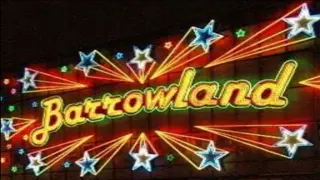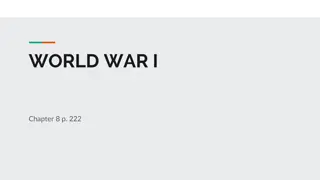The War Moves West and South: Battles and Strategies in the Revolutionary War
Native Americans and Patriots clashed in the West, while sea battles raged with the British navy blockading American harbors. Naval officer John Paul Jones became a hero after a fierce battle. The British shifted focus to the South, facing Patriot victories initially but suffering setbacks due to guerilla warfare tactics.
Download Presentation

Please find below an Image/Link to download the presentation.
The content on the website is provided AS IS for your information and personal use only. It may not be sold, licensed, or shared on other websites without obtaining consent from the author.If you encounter any issues during the download, it is possible that the publisher has removed the file from their server.
You are allowed to download the files provided on this website for personal or commercial use, subject to the condition that they are used lawfully. All files are the property of their respective owners.
The content on the website is provided AS IS for your information and personal use only. It may not be sold, licensed, or shared on other websites without obtaining consent from the author.
E N D
Presentation Transcript
The War Moves West and South CHAPTER 6 SECTION 3
War in the West The Native Americans became entangled in the Revolutionary War. They fought in many of the battles in the West. George Rogers Clark vowed to end British attacks in the west. He set out with 175 soldiers and marched 120 miles to seize the British post Kaskaskia. They then went and captured Vincennes. Some fought for the Patriots while more fought for the British. They seemed like less of a threat. The British fought to get it back but Clark fought to keep it. Many Native Americans worked with the British and led raids against American villages. Thanks to Clark s victory, it strengthened the American position in the West
Glory at Sea While battles were happening in the West, they were also happening at sea. Only 2 of these ships actually made it out to sea. The rest were quickly captured by the British. The powerful British navy formed a blockade around the American harbors, which caused American ships and allied ships unable to enter or leave. This also made it to where they could not receive supplies. Congress then authorized the use of 2000 ships that were privateered-run by private merchants. This made it easier to find crews and were able to capture more British crews than the American Navy. To break the blockade, Congress ordered to build 13 new warships.
John Paul Jones An American naval officer, John Paul Jones, raided many British ports. The Serapis ended up surrendering but Paul s ship the Bonhomme Richard sank not long after. In September of 1779, his ship the Bonhomme Richard met the British ship Serapis. The victory made John Paul Jones a naval hero to the American Patriots. The two ships fought for hours and the British captain asked if John Paul Jones was ready to surrender. His answer was I have not yet begun to fight.
Struggles in the South In the early years of the war, the Patriots won many battles all throughout the South. The British realized that bringing the American colonies back into the British empire would not be easy. They changed their strategy and concentrating their efforts in the South where there were many Loyalists. This strategy worked in the beginning. In 1778, General Clinton sent 3500 troops to take Savannah, GA. In 1780, Clinton himself went down to attack Charles Town, South Carolina. The British won and took thousands of prisoners. This was the worst defeat for the Patriots. General Cornwallis was left in charge of the South and met General Horatio Gates in Camden, SC in battle. The British won but Cornwallis realized he could not control the land they conquered.
Guerilla Warfare The British did not get as much support as expected from the Loyalists. Francis Marion operated the swamps of Eastern South Carolina. As the British troops moved through the countryside, they would be attacked by small bands of Patriot soldiers. He was a guerrilla leader for the Patriots. He was also known as the Swamp Fox He was smart and quick enough to where one British colonel grumbled The devil himself could not catch Marion. They would attack suddenly, strike, then disappear quickly This is called Guerrilla Warfare and caught the British extremely off guard.
Help From Spain Bernardo de Galvez became governor of Louisiana for Spain. Galvez raised an army of Spanish soldiers with Creoles, Native Americans, and African Americans. They marched on British posts along the Mississippi. He supported the Patriots cause and loaned them thousands of dollars for supplies and also opened the port of New Orleans to free trade. They captured Baton Rouge, Natchez, Mobile, and Pensacola. He shipped supplies and ammo up to American troops in the Northwest territory. These victories helped open supply lines for military goods from Spain, France, Cuba, and Mexico. In 1779, Spain declared war on Britain. See quote on pg. 172.
Patriot Victories The British moved through the Carolinas after their victory in Camden. They took 1000 Loyalists and tried to defend an attack from Patriots He split the Army in two and had them fight and win against the British. One attacked in Cowpens while the other joined Marion s Guerrilla raids. The Patriots forced them to retreat and this brought on more support for the Patriots from the Southerners. The forces were reunited to fight against Cornwallis and his army at Guilford Courthouse. Nathaniel Greene took over as Commander of the Patriots in the South Greene s army surrendered but the British suffered heavy losses. Cornwallis abandoned the Carolina campaign.
British Retreat Cornwallis realized that to win the war, British had to act quickly. Cornwallis set up camp at Yorktown and waited further orders from General Clinton in New York He led raids against the Patriots through Virginia and almost captured Governor Thomas Jefferson. The battle for the South was now entering its final phase. Jefferson fled on horseback just ahead of the advancing British troops. General Washington sent Lafayette and General Anthony Wayne to fight against Cornwallis.























